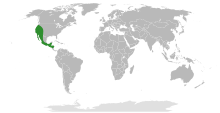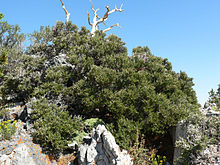Cercocarpus, commonly known as mountain mahogany, is a small genus of at least nine species of nitrogen-fixing[2] flowering plants in the rose family, Rosaceae. They are native to the western United States and northern Mexico, where they grow in chaparral and semidesert habitats and climates, often at high altitudes. Several are found in the California chaparral and woodlands ecoregion.
| Cercocarpus | |
|---|---|

| |
| C. ledifolius var. intricatus | |
| Scientific classification | |
| Kingdom: | Plantae |
| Clade: | Tracheophytes |
| Clade: | Angiosperms |
| Clade: | Eudicots |
| Clade: | Rosids |
| Order: | Rosales |
| Family: | Rosaceae |
| Subfamily: | Dryadoideae |
| Genus: | Cercocarpus Kunth[1] |
| Species | |
|
Several, see text | |

| |
| Synonyms | |
| |

The classification of Cercocarpus within the Rosaceae has been unclear.[3][4] The genus has been placed in the subfamily Rosoideae, but is now placed in subfamily Dryadoideae.[5]
Members of the genus are deciduous shrubs or small trees, typically reaching heights of 3–6 m (9–18 ft) tall, but exceptionally up to 13 m (40 ft) high. C. montanus usually remains under 1 m (3 ft) high because of incessant grazing by elk and deer.
The name is derived from the Greek words κέρκος (kerkos), meaning "tail" and καρπός (karpos), meaning "fruit". It refers to the tail-like plume on the fruits.[6]
Taxonomy
editSpecies
editCercocarpus comprises the following species:[7][8][9][10][11]
- Cercocarpus betuloides Nutt. – birch-leaf mountain mahogany
- var. betuloides Nutt.
- var. blancheae (C.K. Schneid.) Little – island mountain mahogany
- var. traskiae (Eastw.) Dunkle – Catalina Island mountain mahogany
- Cercocarpus breviflorus A. Gray – hairy mountain mahogany
- Cercocarpus douglasii Rydb.
- Cercocarpus fothergilloides Kunth
- var. fothergilloides Kunth
- var. mojadensis (C.K. Schneid.) Henrickson
- Cercocarpus intricatus S.Watson
- Cercocarpus ledifolius Nutt. ex Torr. & A.Gray – curl-leaf mountain mahogany
- Cercocarpus macrophyllus C.K.Schneid.
- Cercocarpus mexicanus Henrard
- Cercocarpus mojadensis C.K.Schneid.
- Cercocarpus montanus Raf.
- var. argenteus (Rydb.) F.L.Martin – silver mountain mahogany
- var. glaber (S.Watson) F.L.Martin
- var. macrourus (Rydb.) F.L.Martin
- var. minutiflorus (Abrams) F.L.Martin – smooth mountain mahogany
- var. montanus Raf. – alder-leaf mountain mahogany
- var. paucidentatus (S.Watson) F.L.Martin
- Cercocarpus pringlei (C.K.Schneid.) Rydb.
- Cercocarpus rotundifolius Rydb.
- Cercocarpus rzedowskii Henrard
Species names with uncertain taxonomic status
editThe status of the following species and hybrids is unresolved:[7]
- Cercocarpus antiquus Lesq.
- Cercocarpus arizonicus M.E.Jones
- Cercocarpus betulaefolius C.K.Schneid.
- Cercocarpus betulaefolius Nutt. ex Hook.
- Cercocarpus breviflorus S.Watson
- Cercocarpus cuneatus Dorf
- Cercocarpus fothergilloides Torr.
- Cercocarpus harneyensis C.A.Arnold
- Cercocarpus macrophyllus C.K.Schneid.
- Cercocarpus miniscalchii (A.Massal.) Principi
- Cercocarpus orestesi Knowlt.
- Cercocarpus pallidus Wooton
- Cercocarpus parviflorus Wooton
- Cercocarpus parvifolius Nutt. ex Hook. & Arn.
- Cercocarpus praefoliolosa R.W.Br.
- Cercocarpus praeledifolius E.W.Berry
- Cercocarpus ravenscragensis E.W.Berry
- Cercocarpus treleasei C.K.Schneid.
References
edit- ^ "Genus: Cercocarpus Kunth". Germplasm Resources Information Network. United States Department of Agriculture. 2004-06-21. Archived from the original on 2012-10-23. Retrieved 2012-04-19.
- ^ "Untitled Document". Archived from the original on 2004-12-25.
- ^ Morgan, D.R., et al. (1994). Systematic and evolutionary implications of rbcL sequence variation in Rosaceae. American Journal of Botany. 81(7): 890–903.
- ^ Eriksson, T., et al. (2003). The phylogeny of Rosoideae (Rosaceae) based on sequences of the internal transcribed spacers (ITS) of nuclear ribosomal DNA and the trnL/F region of chloroplast DNA. International Journal of Plant Sciences. 164: 197–211.
- ^ Potter, D., et al. (2007). Phylogeny and classification of Rosaceae. Plant Systematics and Evolution. 266(1–2): 5–43.
- ^ Quattrocchi, Umberto (2000). CRC World Dictionary of Plant Names. Vol. I: A-C. CRC Press. p. 485. ISBN 978-0-8493-2675-2.
- ^ a b "The Plant List entry for Cercocarpus". The Plant List, v.1.1. Royal Botanic Gardens, Kew and the Missouri Botanical Garden. September 2013. Retrieved 15 December 2020.
- ^ Govaerts R. "Cercocarpus Kunth". Plants of the World Online. Board of Trustees of the Royal Botanic Gardens, Kew. Retrieved 15 November 2022.
- ^ "Cercocarpus". Integrated Taxonomic Information System. Retrieved 2012-04-19.
- ^ "GRIN Species Records of Cercocarpus". Germplasm Resources Information Network. United States Department of Agriculture. Archived from the original on 2009-01-20. Retrieved 2012-04-19.
- ^ "Classification for Kingdom Plantae Down to Genus Cercocarpus Kunth". PLANTS Database. United States Department of Agriculture. Retrieved 2012-04-19.
External links
edit- Media related to Cercocarpus at Wikimedia Commons
- Data related to Cercocarpus at Wikispecies
- Jepson Manual Treatment - Cercocarpus